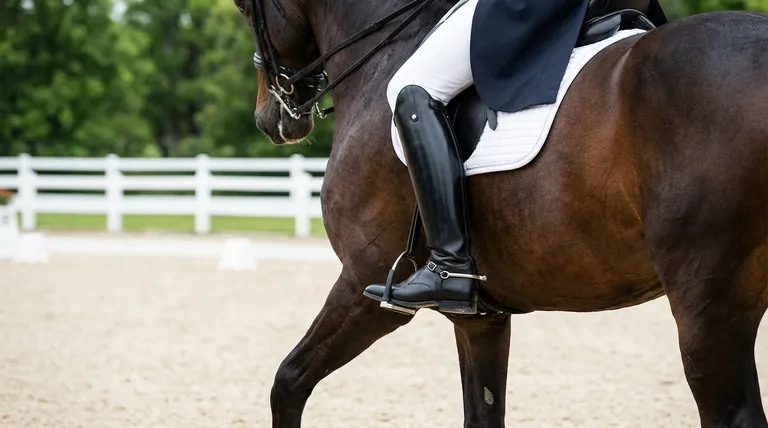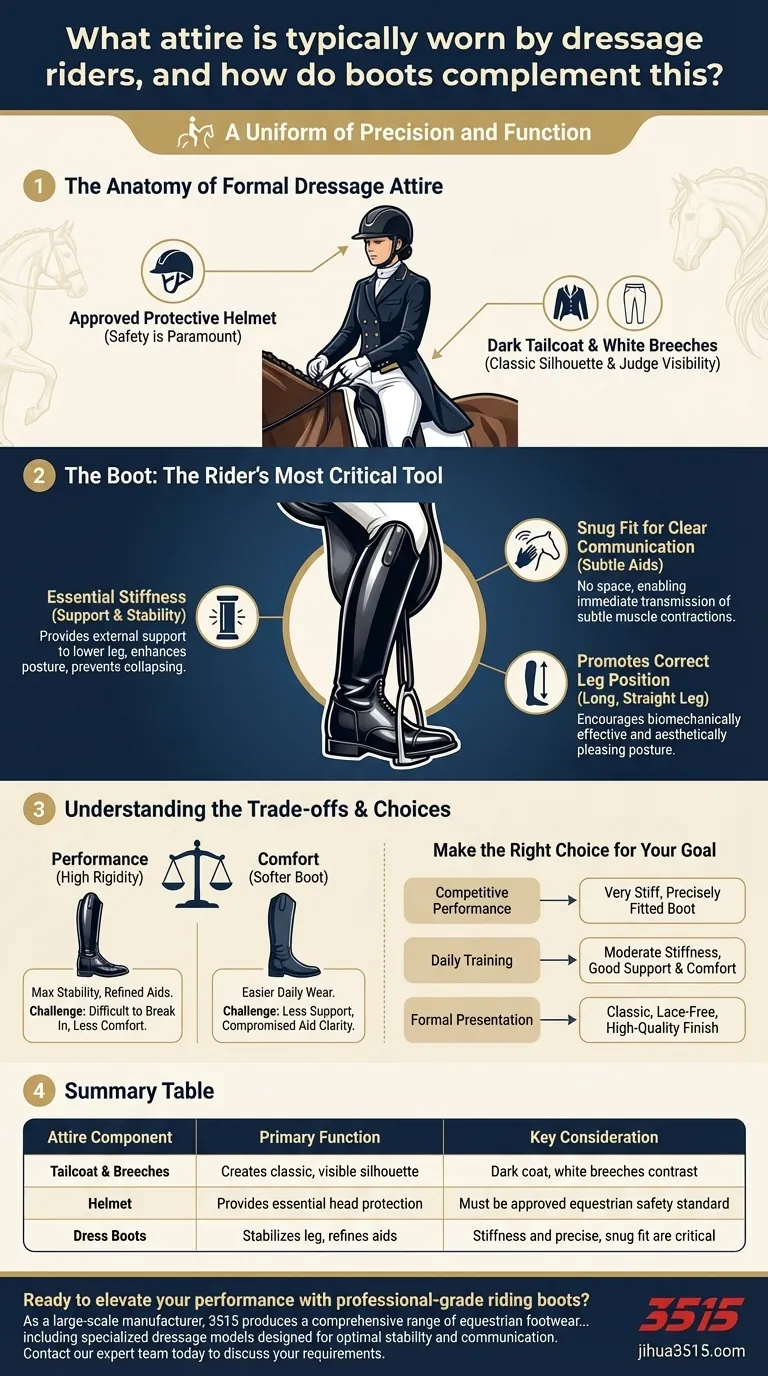At its core, dressage attire is a uniform of precision and function. The typical ensemble for formal competition consists of a dark tailcoat, white breeches, and an approved equestrian helmet. The tall, elegant boots worn are not merely a finishing touch; they are a critical piece of equipment designed to stabilize the rider's leg and refine communication with the horse.
While appearing traditional, formal dressage attire is a highly specialized system. The stiff, form-fitting dress boot, in particular, is the most crucial component, designed to enhance rider stability and enable the subtle leg aids that define the sport.

The Anatomy of Formal Dressage Attire
Every element of the dressage uniform serves a purpose, contributing to a picture of elegance, tradition, and athletic clarity. The goal is to present a harmonious image while optimizing the rider's effectiveness.
The Tailcoat and Breeches
The dark tailcoat and contrasting white breeches create a classic silhouette. This contrast is also functional, making the rider's leg position and aids highly visible to judges, allowing for a more accurate assessment of their technique.
The Protective Helmet
Safety is paramount. All modern dressage attire requires an approved equestrian helmet designed to protect the rider. While styles may vary, the primary function is always protective.
The Boot: The Rider's Most Critical Tool
More than any other piece of attire, the dressage boot directly impacts performance. Its specific design is engineered to support the unique demands of the discipline.
Why Stiffness is Essential
Dress boots are characterized by their stiff construction. This rigidity provides external support to the rider's lower leg, preventing it from collapsing or moving unintentionally. This enhances the rider's overall posture and stability in the saddle.
A Snug Fit for Clear Communication
The boots are designed for a snug, almost custom fit. This ensures there is no space between the rider's calf and the boot leather, allowing even the most subtle muscle contractions to be transmitted clearly and immediately to the horse's side as a cue, or "aid."
Promoting Correct Leg Position
The tall, firm structure of the boot encourages a long, straight leg position. It physically discourages riders from gripping with their knees or calves, promoting the correct posture that is both biomechanically effective and aesthetically pleasing in dressage.
Understanding the Trade-offs
Choosing the right boot involves balancing competing factors. What provides the highest performance might not be the most practical for every situation.
The Performance vs. Comfort Balance
A highly rigid competition boot offers maximum leg stability but can be notoriously difficult and uncomfortable to break in. A softer boot may feel better for daily wear and walking but will provide less support and may compromise the clarity of leg aids.
The Challenge of a Proper Fit
The effectiveness of a dress boot is entirely dependent on its fit. A boot that is too loose will negate all the benefits of stability, while a boot that is too tight can restrict blood flow and be painful. Achieving the perfect, snug fit is often the biggest challenge for a rider.
Making the Right Choice for Your Goal
Your specific needs as a rider should dictate your choice of attire, especially your boots.
- If your primary focus is competitive performance: Prioritize a very stiff, precisely fitted dress boot that offers maximum stability to refine your leg aids.
- If your primary focus is daily training and development: Consider a boot with moderate stiffness that provides good support for correct position but offers more comfort for long hours in the saddle.
- If your primary focus is formal presentation: Choose a classic, lace-free dress boot with a high-quality leather finish, as shiny or decorative details may be appropriate for some competitions but not all.
Ultimately, the right dressage boot is an extension of the rider's leg, turning subtle intent into clear and effective communication.
Summary Table:
| Attire Component | Primary Function | Key Consideration |
|---|---|---|
| Tailcoat & Breeches | Creates a classic, visible silhouette for judging. | Dark coat, white breeches for contrast. |
| Helmet | Provides essential head protection. | Must be an approved equestrian safety standard. |
| Dress Boots | Stabilizes the leg and refines aids to the horse. | Stiffness and a precise, snug fit are critical. |
Ready to elevate your performance with professional-grade riding boots?
As a large-scale manufacturer, 3515 produces a comprehensive range of equestrian footwear for distributors, brand owners, and bulk clients. Our production capabilities encompass all types of riding boots, including specialized dressage models designed for optimal stability and communication.
Let us help you source or develop the perfect boot for your needs. Contact our expert team today to discuss your requirements.
Visual Guide

Related Products
- Factory-Direct Wholesale Canvas Boots with High-Traction Rubber Soles
- Premium Wholesale Waterproof Safety Boots High Performance Protection for Industrial Markets
- Durable Leather Tactical Boots Wholesale & Custom Manufacturing for Brands
- Customizable Anti-Smash Safety Boots for Wholesale & Private Label Manufacturing
- Custom Wholesale Leather Safety Boots Direct Factory Manufacturing
People Also Ask
- What types of work environments are hiker-style rubber outsoles best for? Ideal for Outdoor & Industrial Safety
- What should be avoided when storing boots with outsoles? Protect Your Investment from Dry Rot & Decay
- Why is rubber commonly used for non-slip soles? The Science of Superior Grip
- What types of rubber are typically employed in non-slip footwear soles? Your Guide to Maximum Grip and Safety
- What is a vulcanized sole? Discover the Secret to Superior Flexibility and Grip



















